



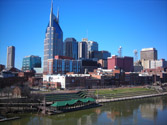

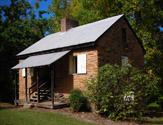









Sunbelt Excursions
Exploring Art and Architecture in Augusta
Augusta, Georgia's second oldest and second largest city, is located along the south bank of the Savannah River, some 150 miles inland from the Atlantic Ocean. Traversed by Interstate 20, Augusta is less than 150 miles east of Atlanta and about 75 miles west of Columbia, making it an ideal destination for both Georgians and South Carolinians seeking a weekend getaway or fun-filled day trip.
Neither an overwhelmingly large metropolis encompassed by a labyrinth of confusing freeways nor an insipid locale devoid of undeniable charm or cultural diversity, Augusta bears much evidence of its past and its evolution into a paradigm of the New South through its embrace of innovation in industry, education and public policy.
A quintessential melting pot of Caucasians, African Americans, Chinese Americans (of whom many descend from Chinese laborers brought to Augusta in the 1870s to work on the canal), Christians, Jews and Muslims of both the working class and social stratum, the city has produced quite a list of important politicos, athletes, educators, writers, musicians and visual artists.
Among Augusta's best-known native creative types are operatic soprano Jessye Norman (b. 1945), contemporary artist Jasper Johns (b. 1930), best-selling novelist Frank Yerby (1916-1991), Grammy Award-winning singer Amy Grant (b. 1960), Tony- and Emmy Award-winning actor Laurence Fishburne (b. 1961) and Oliver Hardy (1892-1957), a partner in the Academy Award-winning comedy duo of Laurel and Hardy. And, of course, Augusta will forever be associated with the Godfather of Soul, James Brown (1933-2006).
Neither an overwhelmingly large metropolis encompassed by a labyrinth of confusing freeways nor an insipid locale devoid of undeniable charm or cultural diversity, Augusta bears much evidence of its past and its evolution into a paradigm of the New South through its embrace of innovation in industry, education and public policy.
A quintessential melting pot of Caucasians, African Americans, Chinese Americans (of whom many descend from Chinese laborers brought to Augusta in the 1870s to work on the canal), Christians, Jews and Muslims of both the working class and social stratum, the city has produced quite a list of important politicos, athletes, educators, writers, musicians and visual artists.
Among Augusta's best-known native creative types are operatic soprano Jessye Norman (b. 1945), contemporary artist Jasper Johns (b. 1930), best-selling novelist Frank Yerby (1916-1991), Grammy Award-winning singer Amy Grant (b. 1960), Tony- and Emmy Award-winning actor Laurence Fishburne (b. 1961) and Oliver Hardy (1892-1957), a partner in the Academy Award-winning comedy duo of Laurel and Hardy. And, of course, Augusta will forever be associated with the Godfather of Soul, James Brown (1933-2006).
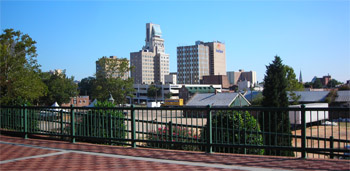
A View of Augusta's Central Business District from the Levee
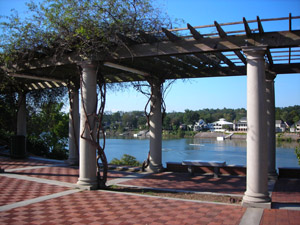
In addition to its people, two of Augusta's greatest assets are its art and architecture. Discussing art and ignoring architecture or vice versa can render insufficient any attempt to shed light on the historical, cultural and academic factors that might have influenced or defined prevailing styles and aesthetic tastes. With its great repository of southern art, vibrant local arts scene and architectural reputation, Augusta is particularly distinctive among other cities of its size, and it is only fitting that the city's art and architecture merit concurrent review.
For Art's Sake
The Morris Museum of Art and the city's Artist's Row are essential stops for anyone wishing to acquaint themselves with Augusta's visual arts scene. Tourists will discover that many of the city's own artists have risen to prominence, and various other artists have resided in Augusta at certain junctures in their careers. Additionally, Augusta is home to art-related events such as the Arts in the Heart of Augusta Festival, which is held on the Augusta Common. Showcasing visual and performance arts, the festival celebrates the diverse ethnicity of Augusta and features live entertainment by local, regional and national performers. Other happenings include juried shows in which artists enter their work and compete for prizes. Such shows benefit emerging and established artists by exposing their work to potential collectors. A helpful resource regarding arts-related functions and events in Augusta is the Greater Augusta Arts Council.
For Art's Sake
The Morris Museum of Art and the city's Artist's Row are essential stops for anyone wishing to acquaint themselves with Augusta's visual arts scene. Tourists will discover that many of the city's own artists have risen to prominence, and various other artists have resided in Augusta at certain junctures in their careers. Additionally, Augusta is home to art-related events such as the Arts in the Heart of Augusta Festival, which is held on the Augusta Common. Showcasing visual and performance arts, the festival celebrates the diverse ethnicity of Augusta and features live entertainment by local, regional and national performers. Other happenings include juried shows in which artists enter their work and compete for prizes. Such shows benefit emerging and established artists by exposing their work to potential collectors. A helpful resource regarding arts-related functions and events in Augusta is the Greater Augusta Arts Council.
The Morris Museum of Art
Foremost on any art connoisseur's itinerary is a visit to the Morris Museum of Art at 1 Tenth Street. Founded in 1985 by Billy Morris in memory of his parents, the Morris Museum opened in 1992 as the first museum in the nation devoted to the art and artists of the American South.
The late Dr. Robert Powell Coggins of suburban Atlanta had amassed an extensive collection of southern art, and Art and Artists of the South: The Robert P. Coggins Collection, a roving exhibition, was well-received at important museums in Nashville, San Antonio, Chattanooga, Huntsville, Richmond, Savannah, Columbia, Charlotte, Atlanta, Jackson and Little Rock from 1984 to 1987. Morris's Southeastern Newspapers Corporation subsequently acquired many of the works contained in the Coggins Collection in 1989, and these were given to the Morris Museum to serve as its foundation. Today, the museum houses more than 5,000 works, including nearly a thousand items bequeathed the museum by the Coggins Art Trust upon the death of Dr. Coggins.
Foremost on any art connoisseur's itinerary is a visit to the Morris Museum of Art at 1 Tenth Street. Founded in 1985 by Billy Morris in memory of his parents, the Morris Museum opened in 1992 as the first museum in the nation devoted to the art and artists of the American South.
The late Dr. Robert Powell Coggins of suburban Atlanta had amassed an extensive collection of southern art, and Art and Artists of the South: The Robert P. Coggins Collection, a roving exhibition, was well-received at important museums in Nashville, San Antonio, Chattanooga, Huntsville, Richmond, Savannah, Columbia, Charlotte, Atlanta, Jackson and Little Rock from 1984 to 1987. Morris's Southeastern Newspapers Corporation subsequently acquired many of the works contained in the Coggins Collection in 1989, and these were given to the Morris Museum to serve as its foundation. Today, the museum houses more than 5,000 works, including nearly a thousand items bequeathed the museum by the Coggins Art Trust upon the death of Dr. Coggins.
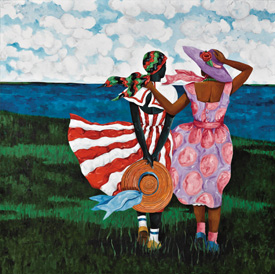
Courtesy of the Morris Museum of Art
Daughters of the South (1993), oil on canvas, Jonathan Green
Since its inception, the Morris Museum has sought to highlight some of the region's finest examples of art through its ever-growing permanent collection and the various exhibitions it presents throughout the year. While the significance of the southern collections at other museums in the region is not to be understated, Kevin Grogan, Curator and Director of the Morris Museum, says, "The greatest strength of the Morris is that it has a very broadly represented southern collection." However, Grogan concedes that the museum's collection is a work in progress, adding, "There are many ways in which we wish to enrich this collection as it grows."
Visitors to the Morris Museum will encounter an ample array of oil and watercolor paintings, sculptures, photographs and other works on paper. Any notions that southern art primarily encompasses idyllic displays of moss-draped live oaks or scenes of black sharecroppers toiling in the cotton fields are quickly put to rest. The galleries contain antebellum portraiture, Civil War-era paintings, still-lifes, landscapes, impressionism and a wide selection of twentieth-century and contemporary works. Artists represented include Joseph Rusling Meeker (1827-1889), Louis Remy Mignot (1831-1871), William Aiken Walker (1838-1921), George Inness Jr. (1853-1926), Alexander John Drysdale (1870-1934), Alice Ravenel Huger Smith (1876-1958), Lamar Dodd (1909-1996), Rev. Howard Finster (1916-2001) and Robert Rauschenberg (1925-2008), as well as native sons Jasper Johns (b. 1930), an internationally-renowned abstract artist, and Edward Rice (b. 1953), an artist noted for his realistic renderings of local architecture. Incidentally, Johns gained even more notoriety when one of his trademark "Flag" paintings from the collection of the late Michael Crichton fetched $28.6 million at Christie's auction house in New York in 2010!
Visitors to the Morris Museum will encounter an ample array of oil and watercolor paintings, sculptures, photographs and other works on paper. Any notions that southern art primarily encompasses idyllic displays of moss-draped live oaks or scenes of black sharecroppers toiling in the cotton fields are quickly put to rest. The galleries contain antebellum portraiture, Civil War-era paintings, still-lifes, landscapes, impressionism and a wide selection of twentieth-century and contemporary works. Artists represented include Joseph Rusling Meeker (1827-1889), Louis Remy Mignot (1831-1871), William Aiken Walker (1838-1921), George Inness Jr. (1853-1926), Alexander John Drysdale (1870-1934), Alice Ravenel Huger Smith (1876-1958), Lamar Dodd (1909-1996), Rev. Howard Finster (1916-2001) and Robert Rauschenberg (1925-2008), as well as native sons Jasper Johns (b. 1930), an internationally-renowned abstract artist, and Edward Rice (b. 1953), an artist noted for his realistic renderings of local architecture. Incidentally, Johns gained even more notoriety when one of his trademark "Flag" paintings from the collection of the late Michael Crichton fetched $28.6 million at Christie's auction house in New York in 2010!
Adding much interest to some of the paintings in the Morris Museum's collection are the various stories that accompany them. For example, Southern Mountain Landscape, North Carolina (c. 1860), a stunningly beautiful painting by William Frerichs (1829-1905), was discovered in a Columbia, South Carolina, pawn shop by John G. Walker and later acquired by the Coggins Collection. The romanticized scene is characterized by the presence of luminism, a term describing "light in transition."
Another intriguing painting is I Can't Sleep (1948), a voyeuristic, tableau vivant of sorts in which a night in the life of artist John McCrady (1911-1968) is glimpsed in his French Quarter New Orleans apartment. McCrady painted himself sitting up in bed with his ears covered while a group of college kids party furiously in the apartment directly above him. Lovers embracing in a second-floor bedroom seem undisturbed by their friends' music and dancing and even more oblivious to the "bawling brat" a mother is attempting to pacify in the apartment on the next level.
Sometimes paintings are evocative and intentionally convey certain themes or messages. The Price of Blood (1868) by Thomas Satterwhite Noble (1835-1907) contains much symbolism and irony in its depiction of a slave trader's sale of his mulatto son.
Another intriguing painting is I Can't Sleep (1948), a voyeuristic, tableau vivant of sorts in which a night in the life of artist John McCrady (1911-1968) is glimpsed in his French Quarter New Orleans apartment. McCrady painted himself sitting up in bed with his ears covered while a group of college kids party furiously in the apartment directly above him. Lovers embracing in a second-floor bedroom seem undisturbed by their friends' music and dancing and even more oblivious to the "bawling brat" a mother is attempting to pacify in the apartment on the next level.
Sometimes paintings are evocative and intentionally convey certain themes or messages. The Price of Blood (1868) by Thomas Satterwhite Noble (1835-1907) contains much symbolism and irony in its depiction of a slave trader's sale of his mulatto son.
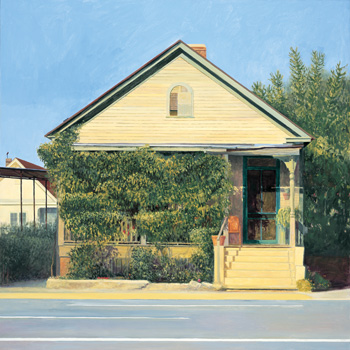
Courtesy of the Morris Museum of Art
1007 Walton Way (1982), oil on canvas, Edward Rice
And, of course, the Civil War-era Surprise Attack Near Harper's Ferry (c. 1868) is an attention-getting work in more ways than one. Author Estill Curtis Pennington wrote in A Southern Collection (Augusta: Morris Communications Corporation, 1992) that artist John A. Mooney (1843-1918) "served through some of the bloodiest campaigns of the war, emerging shell-shocked and desolate." Relying on memory and a few sketches, Mooney painted Surprise Attack in the years following the war. This panoramic oil on canvas, further enhanced by its installation on a curved wall, captures the vulnerable state and terrified expressions of the fleeing soldiers amid John Brown's coup de main. The dramatic scenario in which the male nude is presented markedly contrasts with noteworthy works---namely Thomas Eakins' halcyon Swimming (c. 1883-85) and George Bellows' frolicsome Forty-two Kids (1907)---that would appear later in American art circles. Just as Eakins incorporated his likeness into some of his works, Mooney painted his self-portrait in Surprise Attack. The central figure, the only one directly facing the viewer, is Mooney.
Billy Morris declared in the foreword of A Southern Collection that "each generation produces its painters, sculptors, and artisans who bring fresh, new imagination to what God created and painted long, long ago." And the Morris Museum of Art has certainly assembled a cross section of works that not only resulted from the employment of imagination and creativity, but they uniquely reflect the influence of the American South.
Billy Morris declared in the foreword of A Southern Collection that "each generation produces its painters, sculptors, and artisans who bring fresh, new imagination to what God created and painted long, long ago." And the Morris Museum of Art has certainly assembled a cross section of works that not only resulted from the employment of imagination and creativity, but they uniquely reflect the influence of the American South.
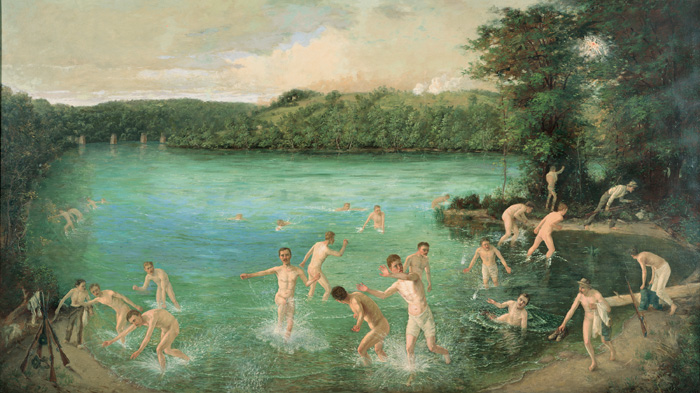
Courtesy of the Morris Museum of Art
Surprise Attack Near Harper's Ferry (c. 1868), oil on canvas, John A. Mooney
The Center for the Study of Southern Art
Not to be overlooked is the Center for the Study of Southern Art, a comprehensive reference library housed in the Morris Museum of Art. Containing more than 13,000 volumes and numerous collections of important papers, the library is an invaluable resource for anyone participating in in-depth art study or conducting scholarly research. While materials are noncirculating and no interlibrary loan services are offered, the library is accessible to museum visitors and questions can be directed to the library's reference desk.
Not to be overlooked is the Center for the Study of Southern Art, a comprehensive reference library housed in the Morris Museum of Art. Containing more than 13,000 volumes and numerous collections of important papers, the library is an invaluable resource for anyone participating in in-depth art study or conducting scholarly research. While materials are noncirculating and no interlibrary loan services are offered, the library is accessible to museum visitors and questions can be directed to the library's reference desk.
Down the Row I Go
Along Broad Street in the heart of downtown Augusta is Artist's Row, a vibrant, revitalized district where the visual arts are not merely a fixture but are a way of life. Teeming with oil and watercolor paintings, sculpture, pottery, photography and other works by artists of local, regional and national renown, Artist's Row caters to serious collectors and casual buyers of virtually every budget and taste.
A perusal of the eclectic galleries reveals works as diverse as Korean Doll ($800), a Carol Sue Roberts still-life painting at Gallery On The Row, and Bamboo Garden ($85), a 6 1/4" vase at Shishir Chokshi's Tire City Potters. Especially popular are the monthly First Friday events for which the galleries and shops of Artist's Row remain open from 5-9 p.m. First Fridays allow art lovers to browse the gallery spaces, interact with artists, grab some dinner and enjoy free live music and other exciting entertainment and events along Broad Street.
Along Broad Street in the heart of downtown Augusta is Artist's Row, a vibrant, revitalized district where the visual arts are not merely a fixture but are a way of life. Teeming with oil and watercolor paintings, sculpture, pottery, photography and other works by artists of local, regional and national renown, Artist's Row caters to serious collectors and casual buyers of virtually every budget and taste.
A perusal of the eclectic galleries reveals works as diverse as Korean Doll ($800), a Carol Sue Roberts still-life painting at Gallery On The Row, and Bamboo Garden ($85), a 6 1/4" vase at Shishir Chokshi's Tire City Potters. Especially popular are the monthly First Friday events for which the galleries and shops of Artist's Row remain open from 5-9 p.m. First Fridays allow art lovers to browse the gallery spaces, interact with artists, grab some dinner and enjoy free live music and other exciting entertainment and events along Broad Street.
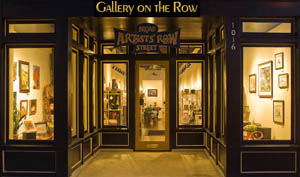
Courtesy of Gallery On The Row
The Galleries & Shoppes of Augusta's Artist's Row
Artistic Perceptions, 551 Broad StreetArt on Broad, 1028 Broad Street
The blue magnolia, 1124 Broad Street
The Book Tavern, 1026 Broad Street
Cloud Nine Natural, 1036 Broad Street
Elduets Treasures of the World, 1127 Broad Street
Frameworks and Tire City Potters, 210B 10th Street
Gallery On The Row, 1016 Broad Street
Gensheer's Studio and Gallery, 105 Marcatan Street
Schweitzer Art Glass Studio, 980 Broad Street
Studio 222, 222 8th Street
Zimmerman Gallery, 1006 Broad Street

The Gertrude Herbert Institute of Art
A mainstay of Augusta's visual arts scene since 1937 is the Gertrude Herbert Institute of Art. Occupying Ware's Folly at 506 Telfair Street, the Herbert Institute is an independent, nonprofit school that offers educational opportunities for students of all ages through quarterly classes and workshops in drawing, painting, photography, weaving, clay and sculpture. Additionally, the Institute hosts major exhibitions of contemporary art throughout the year, showcasing local and regional artists.
Built by former Augusta mayor and U. S. senator Nicholas Ware, the Federal-style Ware's Folly is so named because of the astronomical sum of $40,000 spent for its construction in 1818. The house was acquired by Mrs. Olivia Antoinette Herbert (a wealthy New Yorker who frequently wintered in Augusta) and renovated to provide a permanent home for the Augusta Art Club and a memorial to her late daughter, Gertrude Herbert Dunn. Augusta artist Margaret Ann Smith received training as a youth at the Institute, and local artists like Sandra Whittaker have taken advantage of the school's continuing education opportunities.
A mainstay of Augusta's visual arts scene since 1937 is the Gertrude Herbert Institute of Art. Occupying Ware's Folly at 506 Telfair Street, the Herbert Institute is an independent, nonprofit school that offers educational opportunities for students of all ages through quarterly classes and workshops in drawing, painting, photography, weaving, clay and sculpture. Additionally, the Institute hosts major exhibitions of contemporary art throughout the year, showcasing local and regional artists.
Built by former Augusta mayor and U. S. senator Nicholas Ware, the Federal-style Ware's Folly is so named because of the astronomical sum of $40,000 spent for its construction in 1818. The house was acquired by Mrs. Olivia Antoinette Herbert (a wealthy New Yorker who frequently wintered in Augusta) and renovated to provide a permanent home for the Augusta Art Club and a memorial to her late daughter, Gertrude Herbert Dunn. Augusta artist Margaret Ann Smith received training as a youth at the Institute, and local artists like Sandra Whittaker have taken advantage of the school's continuing education opportunities.
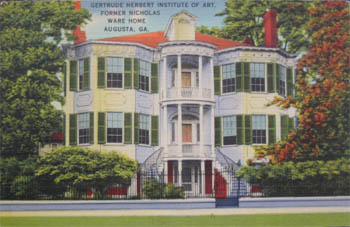
The Gertrude Herbert Institute of Art
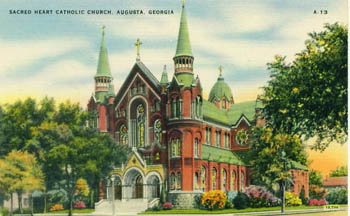
Sacred Heart Cultural Center
Augusta Architecture at a Glance
Compiling a list of Augusta's architectural treasures or thoroughly describing the city's range of architectural styles would most certainly prove daunting, but a number of buildings and districts stand out because of their architectural virtues and historical significance. Visitors taking a drive throughout the city can observe contrasting century-old office buildings, mill village houses, palatial mansions, charming cottages and ornate churches. While some of Augusta's architectural gems have been obliterated by flood and fire and others have been razed, there is much to be seen and appreciated. The Boyhood Home of President Woodrow Wilson and Meadow Garden, the home of George Walton (a Georgia signer of the Declaration of Independence), are definite points of interest, but a more in-depth visit to any number of Augusta's historic districts is bound to prove enlightening.
Compiling a list of Augusta's architectural treasures or thoroughly describing the city's range of architectural styles would most certainly prove daunting, but a number of buildings and districts stand out because of their architectural virtues and historical significance. Visitors taking a drive throughout the city can observe contrasting century-old office buildings, mill village houses, palatial mansions, charming cottages and ornate churches. While some of Augusta's architectural gems have been obliterated by flood and fire and others have been razed, there is much to be seen and appreciated. The Boyhood Home of President Woodrow Wilson and Meadow Garden, the home of George Walton (a Georgia signer of the Declaration of Independence), are definite points of interest, but a more in-depth visit to any number of Augusta's historic districts is bound to prove enlightening.
Erick Montgomery, Executive Director of Historic Augusta, Inc., the local nonprofit organization devoted to historic preservation, says, "We have ten nationally registered historic districts, and three of them are locally designated historic districts. The town was founded in 1736, and we have examples of every architectural style from the Federal period all the way up to the present." For architectural devotees, Montgomery particularly recommends visiting five of the city's historic districts: Downtown, Summerville, Laney-Walker Historic District, Harrisburg-West End Historic District and the Augusta Canal National Heritage Area/Historic Augusta Canal and Industrial District.
Downtown
Downtown Augusta, of which downloadable "walking tour" maps are availabe through Historic Augusta, Inc., contains the commercial and institutional areas, but is also home to the city's oldest residential area. Many important landmarks are adjacent to the levee or within a leisurely stroll of the Riverwalk, including the Augusta Cotton Exchange Building, St. Paul's Episcopal Church and the remaining vestiges of Cotton Row, in the 700 block of Reynolds Street where it was once said that one could "walk a mile on cotton bales."
Downtown
Downtown Augusta, of which downloadable "walking tour" maps are availabe through Historic Augusta, Inc., contains the commercial and institutional areas, but is also home to the city's oldest residential area. Many important landmarks are adjacent to the levee or within a leisurely stroll of the Riverwalk, including the Augusta Cotton Exchange Building, St. Paul's Episcopal Church and the remaining vestiges of Cotton Row, in the 700 block of Reynolds Street where it was once said that one could "walk a mile on cotton bales."
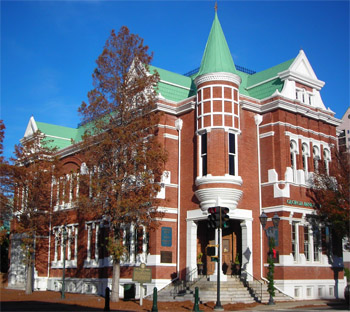
Augusta Cotton Exchange Building
The Augusta Cotton Exchange Building, Cotton Row's pièce de résistance, stands at the corner of Reynolds and Eighth Streets. Built in 1886 by William H. Goodrich, this Second Empire-style building has been attributed to architect Enoch William Brown and features ironwork from the Augusta foundry of Charles F. Lombard, but Montgomery is not convinced that Brown was the only one involved in the design of the structure. There is some speculation that Brown might have collaborated with someone, particularly Goodrich, in the design of this striking landmark. The building, a reminder of the era in which cotton was King, is now occupied by the Georgia Bank & Trust Company of Augusta.
Other downtown buildings of note include designs by G. Lloyd Preacher (1882-1972) such as the Marion (1912) and Lamar (1913) Buildings and Imperial Theatre (1918). Preacher also designed Atlanta's much acclaimed City Hall (1930) and Briarcliff Hotel (1924-1925). Montgomery says, "Preacher particularly got a big boost after the 1916 fire," and Preacher was certainly an integral part of Augusta's rebuilding efforts during that time period.
Augusta's cityscape is not limited to historic properties. Plenty of modern buildings abound, contributing much diversity to the downtown skyline. Even internationally-known architect I. M. Pei (b. 1917) has left his mark. Most conspicuous of his designs is the pyramidal, plate glass-enclosed penthouse atop Broad Street's historic Lamar Building. In the 1970s, Georgia state senator R. Eugene Holly commissioned Pei to make the addition to the terra cotta-clad high-rise which had been designed by Preacher and W. L. Stoddart (who also designed Atlanta's Winecoff and Georgian Terrace Hotels and Ponce de Leon Apartments as well as several Dinkler Hotels properties). While Holly's personal tastes have been scrutinized, the penthouse joined Pei's distinguished portfolio of projects that has come to include Hong Kong's Bank of China Tower, Boston's John F. Kennedy Presidential Library and Museum and Cleveland's Rock and Roll Hall of Fame.
Summerville
Located on "The Hill," the city's higher elevation, the affluent neighborhood of Summerville is primarily residential with many well-preserved buildings dating to the late eighteenth century. Home to some of Augusta's wealthiest and most prominent residents, Summerville was once a fashionable resort destination for those of means, beginning with the opening of the first Hotel Bon Air in 1890. By the late 1920s, however, Summerville's popularity had waned as more northerners flocked to Florida. And, of course, the Great Depression, following the stock market crash of 1929, had its devastating effects.
Other downtown buildings of note include designs by G. Lloyd Preacher (1882-1972) such as the Marion (1912) and Lamar (1913) Buildings and Imperial Theatre (1918). Preacher also designed Atlanta's much acclaimed City Hall (1930) and Briarcliff Hotel (1924-1925). Montgomery says, "Preacher particularly got a big boost after the 1916 fire," and Preacher was certainly an integral part of Augusta's rebuilding efforts during that time period.
Augusta's cityscape is not limited to historic properties. Plenty of modern buildings abound, contributing much diversity to the downtown skyline. Even internationally-known architect I. M. Pei (b. 1917) has left his mark. Most conspicuous of his designs is the pyramidal, plate glass-enclosed penthouse atop Broad Street's historic Lamar Building. In the 1970s, Georgia state senator R. Eugene Holly commissioned Pei to make the addition to the terra cotta-clad high-rise which had been designed by Preacher and W. L. Stoddart (who also designed Atlanta's Winecoff and Georgian Terrace Hotels and Ponce de Leon Apartments as well as several Dinkler Hotels properties). While Holly's personal tastes have been scrutinized, the penthouse joined Pei's distinguished portfolio of projects that has come to include Hong Kong's Bank of China Tower, Boston's John F. Kennedy Presidential Library and Museum and Cleveland's Rock and Roll Hall of Fame.
Summerville
Located on "The Hill," the city's higher elevation, the affluent neighborhood of Summerville is primarily residential with many well-preserved buildings dating to the late eighteenth century. Home to some of Augusta's wealthiest and most prominent residents, Summerville was once a fashionable resort destination for those of means, beginning with the opening of the first Hotel Bon Air in 1890. By the late 1920s, however, Summerville's popularity had waned as more northerners flocked to Florida. And, of course, the Great Depression, following the stock market crash of 1929, had its devastating effects.
Lured by Augusta's mild winters, thousands of wealthy northerners, including industrialists, politicians and socialites, once flocked to Summerville where they could escape the heavy snows and frigid temperatures of the North and enjoy golf, tennis, lawn games, horseback riding and other outdoor activities in relative comfort. Three resort hotels---the Partridge Inn and Bon Air Hotel in Summerville and the Forest Hills-Ricker Hotel in adjacent Forest Hills---and a number of inns and boarding houses accommodated travelers, but some visitors acquired houses or cottages and became part-time residents on "The Hill."
A number of notable architects catered to the moneyed clientele of Summerville, including G. Lloyd Preacher, Willis Irvin Sr. (1891-1950), Henry Ten Eyck Wendell (1861-1917) and the firm of Scroggs & Ewing.
A number of notable architects catered to the moneyed clientele of Summerville, including G. Lloyd Preacher, Willis Irvin Sr. (1891-1950), Henry Ten Eyck Wendell (1861-1917) and the firm of Scroggs & Ewing.
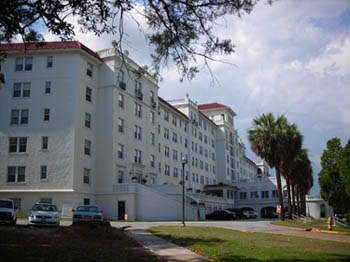
The Bon Air Apartments (formerly the Bon Air Hotel)
Preacher converted the two-story Walton Way residence of New York hotelier Morris Partridge into the Partridge Inn, and Irvin further developed the property years later. Today, the famous hotel is Augusta's only original resort hotel still in operation.
Irvin's stamp on Summerville also includes numerous prominent residences such as the Cozart House and Clark Jack Estate as well as the Bon Air Hotel (1923). The Forest Hills-Ricker Hotel (1927, razed 1988), built in nearby Forest Hills amid a 600-acre park with a golf course designed by Donald Ross, was designed by Irvin in collaboration with Pringle and Smith. Based on his design of the Col. R. R. McCormick house in nearby Aiken, South Carolina, Irvin was awarded the Henry E. Harman Gold Medal for Excellence in Residence Architecture Costing Over $20,000 at the Southern Architectural and Industrial Arts Exposition in Memphis in 1929.
Wendell, who primarily designed houses, came to Augusta around 1908. Born in Waterford, New York, Wendell had earned quite a reputation for his church and residential designs in Denver before relocating to Augusta. Montgomery says, "Wendell's houses are easily recognizable once you understand his style, and his houses are coveted by those who can afford them." Wendell's houses are scattered throughout Summerville. Several can be found on Milledge Road, including a Mediterranean-style home he built between Battle Row and Gardner Street in 1909 for George Stearns. Other Wendell homes can be found on Henry Street and Walton Way, including a cluster of them on Walton Way between Highland Avenue and Peachtree Road.
Irvin's stamp on Summerville also includes numerous prominent residences such as the Cozart House and Clark Jack Estate as well as the Bon Air Hotel (1923). The Forest Hills-Ricker Hotel (1927, razed 1988), built in nearby Forest Hills amid a 600-acre park with a golf course designed by Donald Ross, was designed by Irvin in collaboration with Pringle and Smith. Based on his design of the Col. R. R. McCormick house in nearby Aiken, South Carolina, Irvin was awarded the Henry E. Harman Gold Medal for Excellence in Residence Architecture Costing Over $20,000 at the Southern Architectural and Industrial Arts Exposition in Memphis in 1929.
Wendell, who primarily designed houses, came to Augusta around 1908. Born in Waterford, New York, Wendell had earned quite a reputation for his church and residential designs in Denver before relocating to Augusta. Montgomery says, "Wendell's houses are easily recognizable once you understand his style, and his houses are coveted by those who can afford them." Wendell's houses are scattered throughout Summerville. Several can be found on Milledge Road, including a Mediterranean-style home he built between Battle Row and Gardner Street in 1909 for George Stearns. Other Wendell homes can be found on Henry Street and Walton Way, including a cluster of them on Walton Way between Highland Avenue and Peachtree Road.
The work of Philander P. Scroggs (1888-1960) and Whitley L. Ewing (1888-1953), like that of Irvin or Wendell, is highly regarded, and examples of their work can be found in Summerville and elsewhere. Salubrity Hall at 2259 Cumming Road in Summerville is perhaps the crème de la crème of Scroggs & Ewing houses. Occupying property once belonging to Thomas Sandwich and his Mont Salubrity, a young ladies' seminary, the 11,000 square foot Tudor-style house was completed in 1928 for Mrs. John W. Herbert. So noteworthy was the house that images of the mansion even wound up gracing 1930s Augusta post cards.
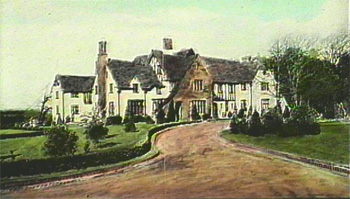
Salubrity Hall
Laney-Walker North Historic District
An African American neighborhood, the Laney-Walker North Historic District was named after Miss Lucy Craft Laney, an educator once referred to as "the mother of the Negro race in Augusta," and Tabernacle Baptist Church founder Dr. Charles T. Walker, whose reputation garnered him invitations to preach in cities like New York and London and prompted John D. Rockefeller, Booker T. Washington and William H. Taft among others to visit Tabernacle to hear a sermon from the "Black Spurgeon."
Laney's residence at 1116 Phillips Street, just off of Laney-Walker Boulevard (formerly Gwinnett Street), is an important point of interest. Now home to the Lucy Craft Laney Museum of Black History, the only African American museum in the Central Savannah River Area, the Laney house contains various collections and exhibitions celebrating African American history and art in Augusta.
Montgomery says, "Laney-Walker Boulevard is the center of African American community. Nearby neighborhoods of Bethlehem and Turpin Hill all have great examples of African American-type housing. By and large, it's wooden clapboard with varying degrees of detail on the porches. They're not all shotgun houses. There are a number of house types."
"The State of Georgia's Historic Preservation Division codified house types several years ago, realizing that many buildings don't have an academic style but they have a type," Montgomery points out. "They realized that there are types of vernacular buildings that could be codified because they were so similar. If you go through some of these neighborhoods, you will see many, many examples of those Georgia-identified house types, and you can find those pretty easily even though they might not have an identifiable style of architecture found in a style reference book."
An African American neighborhood, the Laney-Walker North Historic District was named after Miss Lucy Craft Laney, an educator once referred to as "the mother of the Negro race in Augusta," and Tabernacle Baptist Church founder Dr. Charles T. Walker, whose reputation garnered him invitations to preach in cities like New York and London and prompted John D. Rockefeller, Booker T. Washington and William H. Taft among others to visit Tabernacle to hear a sermon from the "Black Spurgeon."
Laney's residence at 1116 Phillips Street, just off of Laney-Walker Boulevard (formerly Gwinnett Street), is an important point of interest. Now home to the Lucy Craft Laney Museum of Black History, the only African American museum in the Central Savannah River Area, the Laney house contains various collections and exhibitions celebrating African American history and art in Augusta.
Montgomery says, "Laney-Walker Boulevard is the center of African American community. Nearby neighborhoods of Bethlehem and Turpin Hill all have great examples of African American-type housing. By and large, it's wooden clapboard with varying degrees of detail on the porches. They're not all shotgun houses. There are a number of house types."
"The State of Georgia's Historic Preservation Division codified house types several years ago, realizing that many buildings don't have an academic style but they have a type," Montgomery points out. "They realized that there are types of vernacular buildings that could be codified because they were so similar. If you go through some of these neighborhoods, you will see many, many examples of those Georgia-identified house types, and you can find those pretty easily even though they might not have an identifiable style of architecture found in a style reference book."
Harrisburg-West End Historic District
Montgomery states, "Much of our economy since the mid-nineteenth century with the Augusta Canal has been based on the industrial development because of the canal. Harrisburg is the mill village where many of the workers who worked at some of the larger cotton mills from the late nineteenth- to the mid-twentieth century lived." Harrisburg contains a mix of structures and styles that includes shotgun row houses, Queen Anne cottages and store buildings.
Augusta Canal National Heritage Area/Historic Augusta Canal and Industrial District
This linear district starts all the way up in Columbia County and comes into the heart of downtown. Montgomery explains, "Its interest centers not only on the actual water that makes up the canal and parallels the river, but when you get into the urban part of the area there are some outstanding mills that a student of architecture would be delighted to see. One of them is Enterprise Mill, which has been rehabbed." The old mill now houses condominiums and offices, including the Augusta Canal Authority and Augusta Canal Interpretive Center where visitors can learn more about the canal. Daily tours are available, and tourists can even experience an excursion aboard a replica of a Petersburg boat, the type of vessel originally used on the canal.
"Should I Go or Should I Stay?"
Augusta is a great day trip destination for those residing in or near Atlanta, Greenville, Columbia and Savannah, but it has so much to offer that visitors are bound to want to stay longer. A variety of hotels, motels and bed & breakfast inns abound within the city and its suburbs, but two in-town hotels are sure to please.
Situated along the riverfront at Two Tenth Street, the Marriott Hotel and Suites is adjacent to the Morris Museum of Art and within walking distance of Fort Discovery, historic St. Paul's Church and Cotton Row's restaurants. The hotel offers numerous amenities and business services, and accommodations vary from guest rooms with a downtown view to spacious suites overlooking the river. K. C.'s Korner Starbuck's Coffee and a Quiznos sub shop are located on the premises, ensuring that guests need not be deprived of their daily espresso fix or go hungry after spending a few hours at the Morris Museum. (Augustino's Italian Eatery and Prime Steaks, the hotel's upscale restaurant, is discussed in greater detail below.)
Augusta's other standout lodging option is the aforementioned Partridge Inn, one of Augusta's three original resort hotels. Located opposite the former Bon Air Hotel at the corner of Walton Way and Hickman Road in Summerville, the Partridge Inn features luxurious accommodations and "more than a quarter mile of verandahs and balconies wrapping around the hotel."
Touted as the "Grand Hotel of the Classic South," this hotel features period-style furnishings, flatscreen high-definition televisions and health spa amenities. Rates for king and queen guestrooms are comparable to those of other big city hotels, but guests willing to spend more can enjoy the extra space a suite affords or opt for a balcony room. Guests have included Michael Jackson, Bob Dylan, Reba McIntyre, R. Kelly, Charlton Heston, Marla Gibbs, Danny Glover, Dennis Quaid and Herschel Walker.
Additionally, the Partridge Inn "boasts a long legacy of culinary excellence," having hosted a banquet for President Warren G. Harding back in 1923. Its newly refurbished P. I. Bar and Grill offers an immensely popular lunch buffet and Sunday brunch.
Montgomery states, "Much of our economy since the mid-nineteenth century with the Augusta Canal has been based on the industrial development because of the canal. Harrisburg is the mill village where many of the workers who worked at some of the larger cotton mills from the late nineteenth- to the mid-twentieth century lived." Harrisburg contains a mix of structures and styles that includes shotgun row houses, Queen Anne cottages and store buildings.
Augusta Canal National Heritage Area/Historic Augusta Canal and Industrial District
This linear district starts all the way up in Columbia County and comes into the heart of downtown. Montgomery explains, "Its interest centers not only on the actual water that makes up the canal and parallels the river, but when you get into the urban part of the area there are some outstanding mills that a student of architecture would be delighted to see. One of them is Enterprise Mill, which has been rehabbed." The old mill now houses condominiums and offices, including the Augusta Canal Authority and Augusta Canal Interpretive Center where visitors can learn more about the canal. Daily tours are available, and tourists can even experience an excursion aboard a replica of a Petersburg boat, the type of vessel originally used on the canal.
"Should I Go or Should I Stay?"
Augusta is a great day trip destination for those residing in or near Atlanta, Greenville, Columbia and Savannah, but it has so much to offer that visitors are bound to want to stay longer. A variety of hotels, motels and bed & breakfast inns abound within the city and its suburbs, but two in-town hotels are sure to please.
Situated along the riverfront at Two Tenth Street, the Marriott Hotel and Suites is adjacent to the Morris Museum of Art and within walking distance of Fort Discovery, historic St. Paul's Church and Cotton Row's restaurants. The hotel offers numerous amenities and business services, and accommodations vary from guest rooms with a downtown view to spacious suites overlooking the river. K. C.'s Korner Starbuck's Coffee and a Quiznos sub shop are located on the premises, ensuring that guests need not be deprived of their daily espresso fix or go hungry after spending a few hours at the Morris Museum. (Augustino's Italian Eatery and Prime Steaks, the hotel's upscale restaurant, is discussed in greater detail below.)
Augusta's other standout lodging option is the aforementioned Partridge Inn, one of Augusta's three original resort hotels. Located opposite the former Bon Air Hotel at the corner of Walton Way and Hickman Road in Summerville, the Partridge Inn features luxurious accommodations and "more than a quarter mile of verandahs and balconies wrapping around the hotel."
Touted as the "Grand Hotel of the Classic South," this hotel features period-style furnishings, flatscreen high-definition televisions and health spa amenities. Rates for king and queen guestrooms are comparable to those of other big city hotels, but guests willing to spend more can enjoy the extra space a suite affords or opt for a balcony room. Guests have included Michael Jackson, Bob Dylan, Reba McIntyre, R. Kelly, Charlton Heston, Marla Gibbs, Danny Glover, Dennis Quaid and Herschel Walker.
Additionally, the Partridge Inn "boasts a long legacy of culinary excellence," having hosted a banquet for President Warren G. Harding back in 1923. Its newly refurbished P. I. Bar and Grill offers an immensely popular lunch buffet and Sunday brunch.
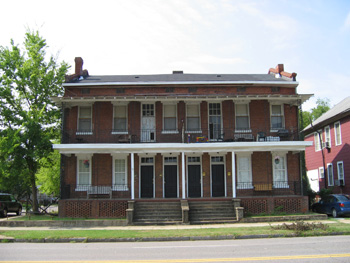
Courtesy of Historic Augusta, Inc.
These flats are located on Broad Street in the traditionally working class Harrisburg-West End Historic District.
"Stop by the church sometime!"
In Augusta, faith has always been an essential part of life, and there are numerous houses of worship of architectural merit. While the Sacred Heart Cultural Center (formerly a Catholic church) and St. Paul's Episcopal Church offer tours, other churches might be open to providing a tour by appointment, and visitors are always welcome to attend worship services. As the lyrics of a gospel song penned by Sullivan Pugh and popularized by singer Babbie Mason declare, "Something might be said to help you on your way, Stop by the church sometime."The Sacred Heart Catholic Church, built in 1900, ceased to be a church in the 1970s. Through the generosity of the Peter S. Knox family, the building located at 1301 Greene Street was rescued from vacancy and vandalism, and reopened in 1987 as the Sacred Heart Cultural Center. Featuring twin spires, a Byzantine dome, graceful arches, turrets, more than a dozen distinctive styles of masonry, ninety-four stained glass windows, a barreled vaulted ceiling and carved Italian marble altars, the building is described by Erick Montgomery of Historic Augusta, Inc. as "the most impressive [church building] architecturally in terms of its complexity and size."
At the corner of Reynolds and Sixth Streets is St. Paul's Episcopal Church, a building Montgomery calls "a symbol of the early history of Augusta." Dating to 1919, the structure looks very much like the 1820 church which was destroyed by the devastating fire of 1916. Following the fire, architect Henry Ten Eyck Wendell took the original design by John Lund and elongated it. Montgomery says, "He essentially duplicated the exterior, although he changed the windows' slight Gothic arches to Roman arches. The interior of St. Paul's had changed with the different eras of the church according to secular and Ecclesiastical tastes. He started all over again, and gave it a glorious high Georgian interior." St. Paul's is a convenient stroll from the Marriott Hotel and Suites and restaurants.
Now located on Walton Way, First Baptist Church once occupied the beautiful building (circa 1902) still standing at the corner of Eighth and Greene Streets. In the building previous to the 1902 sanctuary at the same location, the Southern Baptist Convention was founded in 1845.
An African American church of small size and limited resources, Union Baptist Church at 1104 Greene Street and its parsonage located behind the sanctuary on Eleventh Street have undergone much restoration thanks to a significant amount of money raised by Historic Augusta, Inc. Montgomery says, "Union is a Carpenter Gothic wooden church building, a rare example left in this area of that style of architecture. It is a real gem."
Of Romaneque Revival style with Gothic elements, First Christian Church at Seventh and Greene Streets has a unique history. Montgomery explains, "First Christian was built in the 1870s by a philanthropist in town named Emily Tubman, who was very well-known around here for supporting women's education and many worthwhile causes in the nineteenth century. It was her church, and she bore the entire expense for the construction of the building in 1875. It is a lasting legacy for her."
The sanctuary of First Presbyterian Church at Telfair and Sixth Streets has been used continuously by the same congregation for nearly two hundred years. Built between 1809 and 1812, the church was designed by Robert Mills, America's first native-born trained architect. Originally from Charleston, Mills was working for the Philadelphia firm of Benjamin Latrobe when he designed First Presbyterian after responding to a design competition. The building, however, was altered in the 1840s. President Woodrow Wilson attended services at First Presbyterian as a boy. His father, Dr. Joseph Riggles Wilson, was the minister from 1858 to 1870, and the General Assembly of the Presbyterian Church in the United States was formed here in 1861.
Arguably the oldest independent African American church in the nation is Springfield Baptist Church at Reynolds and Twelfth Streets. The Augusta Baptist Institute, a school that would later move to Atlanta and become Morehouse College, was founded here. The church was also the site of the first meeting of the Georgia Equal Rights Association, the precursor to the Georgia Republican Party. Montgomery calls Springfield a "remarkable place." Two buildings---one a simple 1801 meeting house acquired from Augusta's first Methodist Society, the other an 1897 Late Victorian Gothic brick building designed by Albert Whitner Todd (1856-1924)---occupy the property.
Lastly, Tabernacle Baptist Church on Laney-Walker Boulevard is another architecturally significant church with an illustrious history. While the original 1885 building stood on Ellis Street, the current Italian Renaissance-influenced structure was built in 1915 and, as Montgomery puts it, is "an outstanding architectural building."
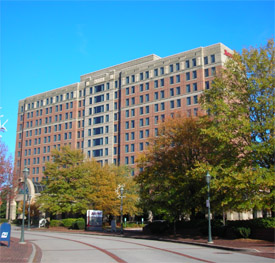
Augusta Marriott Hotel and Suites
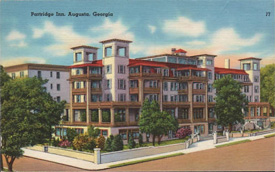
The Partridge Inn
From Soul Food to Cucina Italiana
For anyone with an insatiable appetite for art and architecture, Augusta has much to offer. As for those who have an appreciation for the culinary arts or are otherwise downright hungry, the city has an abundance of familiar chain restaurants as well as a number of unique, memorable dining experiences, including several in the downtown area near the Riverwalk.
For anyone with an insatiable appetite for art and architecture, Augusta has much to offer. As for those who have an appreciation for the culinary arts or are otherwise downright hungry, the city has an abundance of familiar chain restaurants as well as a number of unique, memorable dining experiences, including several in the downtown area near the Riverwalk.
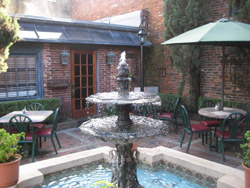
Promoted as the place "where old friends get together and new friends meet," The Cotton Patch, located at 816 Cotton Lane, offers Lowcountry-influenced selections such as Charleston Chicken (chicken breast covered with grilled shrimp and topped with a jalapeno cream sauce). Other entrées include Big Country Chops (two fresh cut juicy 7-ounce pork chops slow-grilled, glazed with apple butter and smothered with grilled onions) and Lumberjack Steak (a 12-ounce special marinated ribeye). Golf magazine rated The Cotton Patch one of Augusta's top three dining destinations.
At 10 Ninth Street, the Boll Weevil Café & Sweetery occupies a former cotton warehouse from the 1850s. The restaurant, particularly noted for its desserts, has been praised by Southern Living, Cooking with Paula Deen, Augusta magazine and others. Southern favorites as well as the Havana Chicken (grilled jerk chicken served with dirty rice and black beans and topped with cheese) and Salmon Meridian (salmon served atop fried green tomatoes with a corn chutney and a drizzle of balsamic reduction) will not disappoint. Boll Weevil's expansive dessert menu includes such delectable creations as Red Velvet Cake and Peaches and Cream Cheesecake, but the restaurant especially prides itself in preparing masterpieces such as the Perfect Chocolate Cake (a chocolate addict's dream that towers over twelve inches in height!) and 7th Heaven Cake (two layers of chocolate cake sandwiching a layer of white chocolate cheesecake covered in buttercream, topped with ganache and chocolate chips).
At 10 Ninth Street, the Boll Weevil Café & Sweetery occupies a former cotton warehouse from the 1850s. The restaurant, particularly noted for its desserts, has been praised by Southern Living, Cooking with Paula Deen, Augusta magazine and others. Southern favorites as well as the Havana Chicken (grilled jerk chicken served with dirty rice and black beans and topped with cheese) and Salmon Meridian (salmon served atop fried green tomatoes with a corn chutney and a drizzle of balsamic reduction) will not disappoint. Boll Weevil's expansive dessert menu includes such delectable creations as Red Velvet Cake and Peaches and Cream Cheesecake, but the restaurant especially prides itself in preparing masterpieces such as the Perfect Chocolate Cake (a chocolate addict's dream that towers over twelve inches in height!) and 7th Heaven Cake (two layers of chocolate cake sandwiching a layer of white chocolate cheesecake covered in buttercream, topped with ganache and chocolate chips).
Courtesy of The Cotton Patch

Courtesy of The Boll Weevil Café and Sweetery
The bill of fare at Augustino's Italian Eatery and Prime Steaks, a popular restaurant located on the premises of the Augusta Marriott Hotel and Suites, is "inspired by the food of Northern Italy," and also includes Certified Angus Beef. Appetizers include Steamed Mussels, Fried Calamari and Crispy Asparagus Italiana (fresh asparagus breaded, golden fried and served with Parmesan aioli). Pasta choices include Bolognese Lasagna, Spinach Canelloni, Traditional Linguini and Meatballs and Pasta Antonio (a colorful blend of tricolor bow-tie pasta tossed with pancetta, tri-colored peppers, grilled chicken strips, artichoke hearts, green onions and Asiago cream sauce). Steak lovers will love the Bone-in Ribeye, Filet Mignon or Augustino's Special Steak (a roasted Certified Angus strip stuffed with fresh peppers, onions, roasted garlic, diced crispy bacon and green olives topped with Cacciatore sauce and served over linguini). And the ample selection of desserts includes Double Chocolat Bundt Cake, Berry Tiramisu and Crème Brûlée Cheesecake.
Off the Beaten Path
For golf's most esteemed competitors and many of its most avid fans, Augusta is indeed a mecca. However, a visual extravaganza awaits those who have a penchant for some of the American South's most remarkable art and architecture. Best of all, Augusta is not that far off the beaten path. And it is well worth the journey.
Off the Beaten Path
For golf's most esteemed competitors and many of its most avid fans, Augusta is indeed a mecca. However, a visual extravaganza awaits those who have a penchant for some of the American South's most remarkable art and architecture. Best of all, Augusta is not that far off the beaten path. And it is well worth the journey.
The author gratefully acknowledges the assistance of Kevin Grogan, Executive Director and Curator, Morris Museum of Art; Nicole McLeod, Director of Marketing and Public Relations, Morris Museum of Art; Erick Montgomery, Executive Director, Historic Augusta, Inc.; Robyn Mainor Anderson, Preservation Services Director, Historic Augusta, Inc.; Bryan Mitchell, Owner, The Cotton Patch; Courtney Dawn Cooper, General Manager, The Boll Weevil Café & Sweetery; Artist Sandra Whittaker, Gallery On The Row; Ngaire Smith, Reference Department, University of Georgia Libraries, Athens.
BIBLIOGRAPHY
Augusta Unit, Federal Writers' Project, Works Progress Administration. Augusta (Augusta: City Council of Augusta, 1938).
Edward J. Cashin, The Story of Augusta (Augusta: Richmond County Board of Education, 1980).
LaTina Emerson, "The Partridge Inn celebrates 100 years today," The Augusta Chronicle, January 8, 2010.
Lucian Lamar Knight, A Standard History of Georgia and Georgians, Volume V (Chicago and New York: The Lewis Publishing Company, 1917).
Mills Lane, Architecture of the Old South: Georgia (New York: Abbeville Press, 1986).
Louis LeBeaume, "The Southern Architectural & Industrial Arts Exposition, Memphis, Tennessee, November 9th t0 16th, 1929: Report of the Jury," Southern Architect and Building News, December 1929.
Estill Curtis Pennington, A Southern Collection (Augusta: Morris Communications Corporation, 1992).
A. Ray Rowland and Helen Callahan, Yesterday's Augusta (Miami: E. A. Seemann Publishing, Inc., 1976).
Joseph Sapia, "Mansions diverse stories tied to family, civic life," East Brunswick Sentinel, June 27, 2002.
Tom Spector, The Guide to the Architecture of Georgia (Columbia: University of South Carolina Press, 1993).
Robert W. Tebbs, Scroggs & Ewing, Architecture and Design: This Issue Devoted to the Work of Scroggs and Ewing (New York: Architectural Catalog Company, 1937).
Carl Vogel, "At Christie's, a $28.6 Million Bid Sets a Record for Johns," The New York Times, May 11, 2010.
Henry F. Withey and Elsie Rathburn Withey, Biographical Dictionary of American Architects (Deceased) (Los Angeles: New Age Publishing Company, 1956).
"Augusta," New Georgia Encyclopedia, Retrieved March 6, 2010: http://www.newgeorgiaencyclopedia.org
"G. Lloyd Preacher (1882-1972)," New Georgia Encyclopedia, Retrieved June 12, 2010: http://www.newgeorgiaencyclopedia.org
"Springfield Baptist Church," New Georgia Encyclopedia, Retrieved June 12, 2010: http://www.newgeorgiaencyclopedia.org
"Late Victorian Architecture: Overview," New Georgia Encyclopedia, Retrieved June 12, 2010: http://www.newgeorgiaencyclopedia.org
OTHER SOURCES
Telephone conversation with Erick Montgomery, Executive Director, Historic Augusta, Inc., on July 21, 2010.
Telephone conversation with Kevin Grogan, Executive Director and Curator, Morris Museum of Art, on August 9, 2010.
Augusta Unit, Federal Writers' Project, Works Progress Administration. Augusta (Augusta: City Council of Augusta, 1938).
Edward J. Cashin, The Story of Augusta (Augusta: Richmond County Board of Education, 1980).
LaTina Emerson, "The Partridge Inn celebrates 100 years today," The Augusta Chronicle, January 8, 2010.
Lucian Lamar Knight, A Standard History of Georgia and Georgians, Volume V (Chicago and New York: The Lewis Publishing Company, 1917).
Mills Lane, Architecture of the Old South: Georgia (New York: Abbeville Press, 1986).
Louis LeBeaume, "The Southern Architectural & Industrial Arts Exposition, Memphis, Tennessee, November 9th t0 16th, 1929: Report of the Jury," Southern Architect and Building News, December 1929.
Estill Curtis Pennington, A Southern Collection (Augusta: Morris Communications Corporation, 1992).
A. Ray Rowland and Helen Callahan, Yesterday's Augusta (Miami: E. A. Seemann Publishing, Inc., 1976).
Joseph Sapia, "Mansions diverse stories tied to family, civic life," East Brunswick Sentinel, June 27, 2002.
Tom Spector, The Guide to the Architecture of Georgia (Columbia: University of South Carolina Press, 1993).
Robert W. Tebbs, Scroggs & Ewing, Architecture and Design: This Issue Devoted to the Work of Scroggs and Ewing (New York: Architectural Catalog Company, 1937).
Carl Vogel, "At Christie's, a $28.6 Million Bid Sets a Record for Johns," The New York Times, May 11, 2010.
Henry F. Withey and Elsie Rathburn Withey, Biographical Dictionary of American Architects (Deceased) (Los Angeles: New Age Publishing Company, 1956).
"Augusta," New Georgia Encyclopedia, Retrieved March 6, 2010: http://www.newgeorgiaencyclopedia.org
"G. Lloyd Preacher (1882-1972)," New Georgia Encyclopedia, Retrieved June 12, 2010: http://www.newgeorgiaencyclopedia.org
"Springfield Baptist Church," New Georgia Encyclopedia, Retrieved June 12, 2010: http://www.newgeorgiaencyclopedia.org
"Late Victorian Architecture: Overview," New Georgia Encyclopedia, Retrieved June 12, 2010: http://www.newgeorgiaencyclopedia.org
OTHER SOURCES
Telephone conversation with Erick Montgomery, Executive Director, Historic Augusta, Inc., on July 21, 2010.
Telephone conversation with Kevin Grogan, Executive Director and Curator, Morris Museum of Art, on August 9, 2010.
Author: Greg Freeman. Published August 12, 2010.
Copyright
Southern Edition
All Rights Reserved
Southern Edition
All Rights Reserved
All materials contained on this site, including text and images, are protected by copyright laws and may not be reproduced without prior written permission from the publisher. Where applicable, use of some items contained on this site may require permission from other copyright owners.
Fair Use of text from SouthernEdition.com is permitted to the extent allowed by copyright law. Proper citation is requested. Please use this guide when citing a Southern Edition article.
Contact Greg Freeman or SouthernEdition.comFair Use of text from SouthernEdition.com is permitted to the extent allowed by copyright law. Proper citation is requested. Please use this guide when citing a Southern Edition article.